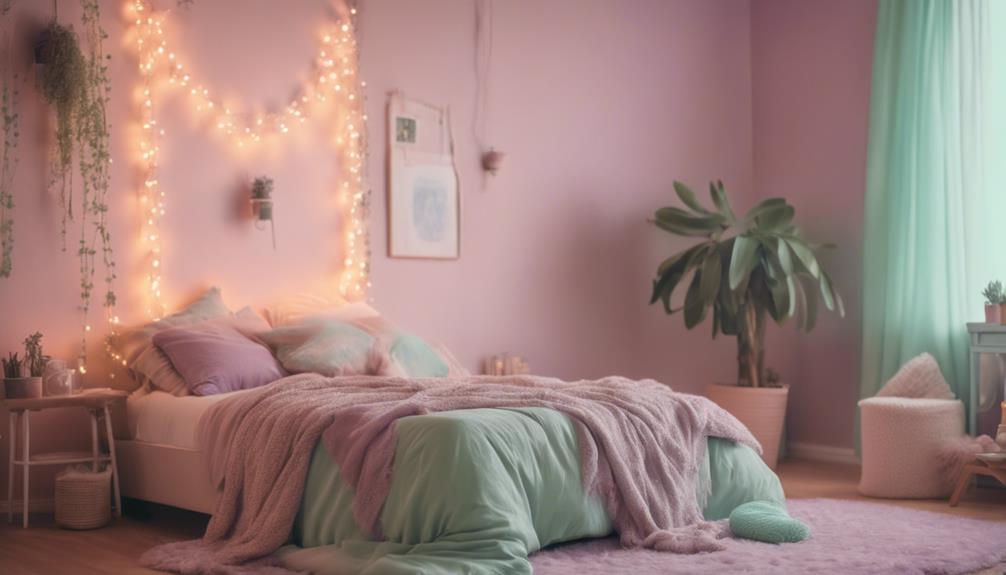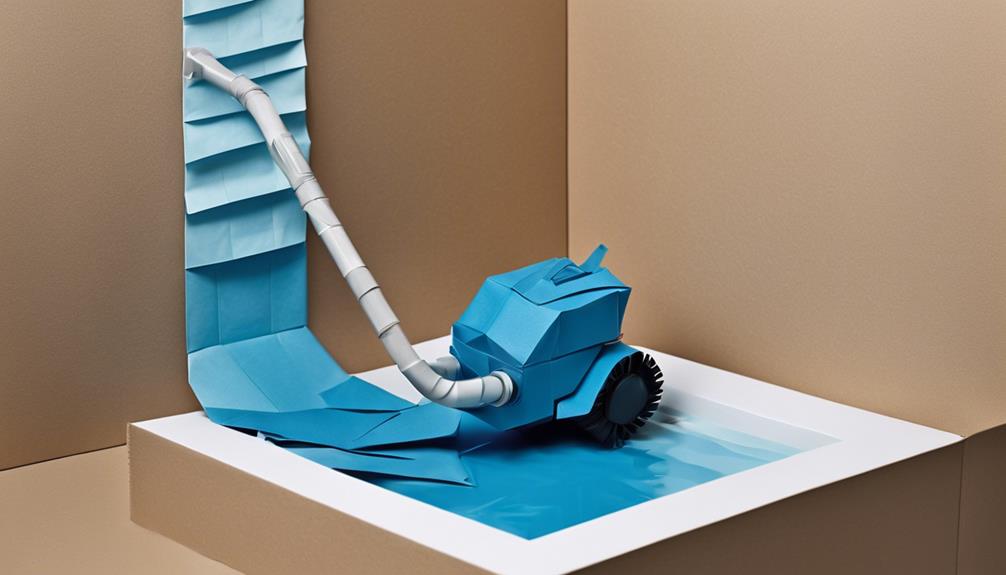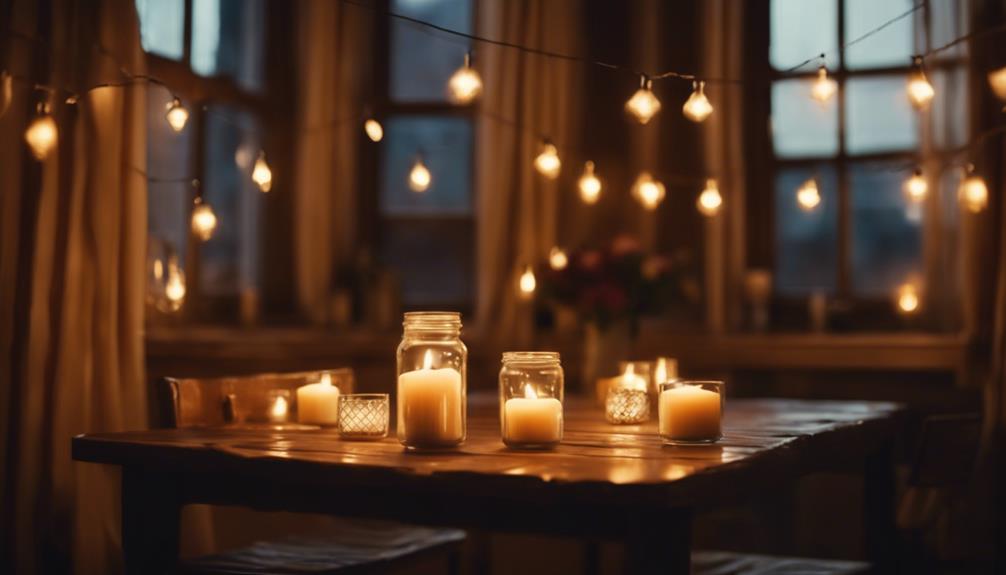To create a pastel aesthetic room, start with soft hues like powder pink and mint green on your walls. Mix these colors in furniture, using breathable materials like cotton and velvet for a cozy feel. Incorporate pastel lighting, like soft pendant lights and fairy string lights, to enhance ambiance. Layer textures with fluffy pillows and quilted bedding for warmth. Accent your space with decorative elements such as ceramic vases and wall art featuring floral designs. Add personal touches with pastel cushions and unique decor items. There's much more to explore about achieving this dreamy look!
Key Elements

To create the perfect pastel aesthetic room, you need to focus on three key elements: color scheme, materials, and textures.
Start by selecting soft hues that harmonize together, then choose light furniture that complements those colors.
Color Scheme
A successful pastel aesthetic room features a color palette of soft, muted hues like powder pink, lilac, mint green, and light lemon yellow, creating a serene atmosphere. To achieve this look, start with white walls as your backdrop. This allows the pastel colors to stand out while maintaining a clean, cohesive environment.
When selecting your palette, don't hesitate to mix different pastel shades. Combining pink hues with mint green or light gray can enhance the richness and harmony of your design, making the space feel more inviting.
Light-colored furniture, in shades of white or subdued pastels, reinforces that calming and airy feel typical of pastel aesthetics. Think about incorporating natural textures and subtle patterns in your bedding or decor. This adds depth and visual interest without clashing with the overall soft aesthetic.
Materials
Incorporating pastel-colored furniture, like soft pink or mint green pieces, helps create a cohesive and calming aesthetic in your room. To enhance the overall look, choose light and breathable materials, such as cotton for your bedding and curtains. This not only guarantees comfort but also maintains the pastel theme throughout the space.
In addition to your main furniture, think about unique decor items that embody pastel colors. Items like pastel clay coasters, plushie pillows, and cute neon signs can add charm and personality to your room. Layering different pastel shades in textiles, such as quilts and throws, creates depth and richness in your design.
Don't forget about the importance of soft materials. Opt for gentle fabrics like velvet or microfiber for cushions and throws, which will enhance the cozy vibe of your pastel decor. Also, consider incorporating natural elements, such as wooden furniture, which can complement the pastel palette and promote a soothing atmosphere.
Textures
Choosing the right textures brings your pastel aesthetic room to life, adding depth and interest while maintaining a soothing atmosphere. Incorporating various textures is key to creating that cozy ambiance you desire.
Start with quilted bedding and soft fluffy pillows to introduce warmth and comfort. Knitted throws also add a tactile element that invites relaxation.
Natural textures, like wooden furniture and woven baskets, beautifully complement pastel hues, enhancing the calming aesthetic of your space. Mixing different materials, such as cotton, linen, and velvet, elevates the luxurious feel while guaranteeing everything remains soft to the touch.
Layering textiles is another great strategy. Consider sheer curtains that gently filter light paired with thick rugs that ground the room. This combination not only adds visual interest but also enhances the cozy ambiance you want to achieve.
Lastly, prioritize breathable materials in your bedding, like 100% cotton, to guarantee comfort while maintaining the soothing aesthetic.
Essential Fixtures and Furniture

When it comes to essential fixtures and furniture for your pastel aesthetic room, you'll want to focus on pieces that enhance the soft, calming vibe.
A pastel-colored accent chair or a bookshelf with curved shelves can add both style and functionality.
Don't forget to include a pastel upholstered ottoman for extra seating and a pop of color.
Pastel-Colored Accent Chair
A pastel-colored accent chair can instantly elevate your room's aesthetic, blending comfort with a stylish focal point in soft hues like mint green or blush pink. This chair not only provides a cozy spot to relax but also enhances the overall look of your pastel-themed space.
Opt for a pastel accent chair with rounded edges and minimalistic designs to maintain the airy feel characteristic of pastel decor. Choose fabrics like velvet or soft cotton to create a luxurious atmosphere while ensuring comfort.
Pair your accent chair with coordinating decorative pillows or throws in similar shades to establish a cohesive and inviting seating area. This combination not only ties the room together but also adds an extra layer of softness and style.
Incorporating a pastel accent chair alongside light-colored furniture and decor helps maintain visual balance and promotes a serene ambiance throughout the room.
With the right choice, your accent chair will become a standout feature, drawing attention while harmonizing beautifully with the rest of your pastel aesthetic. So, go ahead and select a chair that speaks to you and complements your vision!
Pastel Bookshelf With Curved Shelves
Incorporating a pastel bookshelf with curved shelves can beautifully complement your accent chair, adding a whimsical touch that enhances the overall pastel aesthetic of your room. The gentle lines of the curved shelves soften the sharp angles often found in furniture, promoting a cohesive and inviting atmosphere.
When selecting your pastel bookshelf, opt for materials like light wood or painted MDF in soft hues such as mint green or blush pink. This choice guarantees your bookshelf harmonizes with other pastel decor elements in your space. The unique design of curved shelves not only offers visual interest but also provides practical storage solutions for books, decorative items, and even plants.
To further elevate the charm of your pastel bookshelf, incorporate pastel-colored books and decorative objects like ceramic vases or framed art. These elements will blend perfectly with the whimsical design while maintaining the pastel theme.
Additionally, consider pairing the bookshelf with complementary pastel furniture, such as a light-colored desk or chair, to create a harmonious reading nook. This combination will enhance your room's aesthetic and provide a cozy space for relaxation and inspiration.
Pastel Upholstered Ottoman
Adding a pastel upholstered ottoman instantly enhances your room's functionality while infusing it with color and charm. This versatile piece serves as extra seating and offers storage options, making it a practical addition to your pastel aesthetic room. Available in various pastel shades like mint green, blush pink, and lavender, these ottomans complement your decor while adding a delightful pop of color.
Choosing soft, plush fabrics such as velvet or cotton not only boosts comfort but also contributes to the cozy atmosphere you're aiming for. You can easily find ottomans with unique shapes or patterns that act as statement pieces, elevating the overall design of your space.
When selecting a pastel upholstered ottoman, think about its size and scale to guarantee it fits harmoniously within your room's layout. Consider how it interacts with other furniture elements in your pastel room decor.
Lighting Ideas
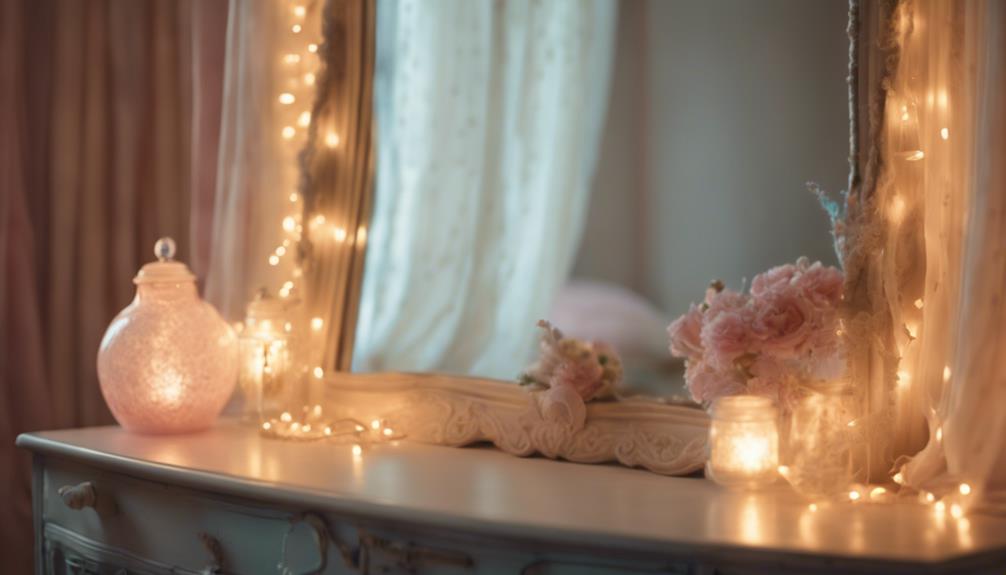
When it comes to lighting your pastel aesthetic room, choosing the right fixtures can make all the difference.
Consider adding a pastel pendant light fixture or soft fairy string lights to create a whimsical touch.
Pastel table lamps and wall sconces can also enhance the ambiance, ensuring your space feels cozy and inviting.
Pastel Pendant Light Fixture
A pastel pendant light fixture can instantly transform your room into a serene haven, offering both style and ambiance in hues like blush pink, mint green, and pale yellow. These soft hues perfectly complement the pastel aesthetic, creating a calming atmosphere that invites relaxation.
When selecting a pastel pendant light, consider unique designs—geometric shapes or whimsical elements can enhance the playful nature of your space. Materials like frosted glass or ceramic are ideal, as they provide soft, diffused light that maintains the tranquil vibe you're aiming for.
Adjustable-height fixtures add versatility to your lighting design, allowing you to create the perfect ambiance for various activities, whether it's reading, studying, or entertaining.
For maximum impact, pair your pastel pendant lights with neutral or light-colored ceilings and walls. This not only highlights the fixture as a focal point but also keeps the overall look cohesive and airy.
Pastel Fairy String Lights
Pastel fairy string lights bring a whimsical charm to your room, creating a cozy and enchanting atmosphere that enhances the pastel aesthetic. Available in soft pink, mint green, and light lavender, these lights perfectly complement your pastel decor, adding a touch of color while maintaining a serene vibe.
You can easily drape them along walls or around furniture to create a magical backdrop. The calming effects of these lights make them ideal for relaxing evenings or cozy gatherings. Many options come with adjustable settings, allowing you to choose between steady light or twinkling effects, personalizing the ambiance to fit your mood.
Battery-operated pastel fairy string lights offer versatility in placement, freeing you from the constraints of outlets. This flexibility makes them perfect for unique arrangements in small spaces. Consider incorporating them into a gallery wall or above your bed, where they can serve as both decorative and functional lighting.
The soft glow promotes relaxation, enhancing the overall atmosphere of your pastel aesthetic room. So, get creative and let these lights illuminate your space with charm and tranquility!
Pastel Table Lamp With Shade
Choosing a pastel table lamp with a soft-hued shade can effortlessly elevate the calming ambiance of your room while providing both functional and decorative lighting. Look for lamps in muted colors like mint green, pale pink, or lavender to seamlessly blend with your pastel decor. These colors not only enhance the aesthetic but also add a touch of elegance to your space.
Consider selecting a lamp with unique shapes or playful designs—rounded bases or whimsical motifs can perfectly complement the light-hearted nature of the pastel aesthetic. The soft, diffused lighting from a pastel table lamp creates a cozy atmosphere, ideal for unwinding after a long day.
To enhance your room's overall look, pair your pastel table lamp with decorative elements like pastel-colored books, vases, or artwork. This cohesive approach ties the room together, making it feel balanced and inviting.
Pastel Wall Sconce Lighting
Incorporating soft-hued wall sconces can beautifully enhance the calming atmosphere of your pastel aesthetic room. Choose pastel wall sconces in shades like blush pink, mint green, or lavender to create a soothing ambiance that seamlessly blends with your decor. Unique designs, such as wavy shapes or floral motifs, can add a whimsical touch, perfectly complementing the playful nature of pastel decor.
Dimmable pastel sconces are a great option, allowing you to adjust the lighting to promote a relaxing atmosphere, especially when winding down after a long day. Pair these sconces with white or light-colored walls to maximize their impact, allowing the soft tones to illuminate your space without overwhelming it.
To elevate the visual depth of your pastel-themed room, consider incorporating pastel wall sconces alongside other lighting sources like fairy lights or neon signs. This layering creates a more dynamic environment, enhancing both the aesthetics and the overall mood.
Decorative Elements
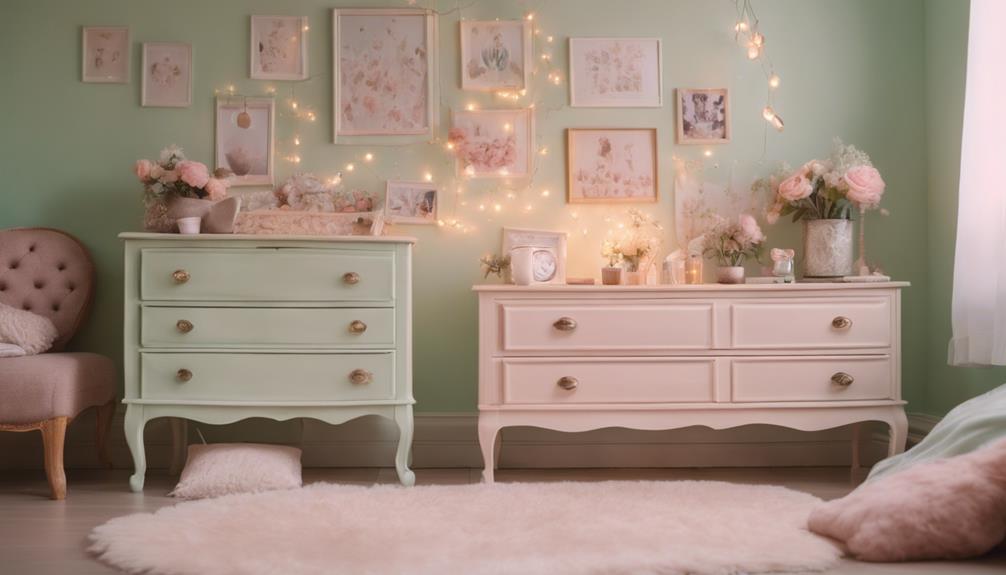
To truly capture a pastel aesthetic, you'll want to focus on decorative elements that bring your space to life.
Think about incorporating pastel ceramic vases as centerpieces, vibrant wall art prints, and playful geometric wall decals.
These accents not only enhance the overall theme but also add personality to your room.
Pastel Ceramic Vase Centerpiece
How can a pastel ceramic vase serve as a stunning centerpiece in your decor? These vases, available in a variety of shapes and sizes—from round and bulbous to slender and elongated—offer you diverse styling options that enhance your pastel aesthetic room. With soft colors like pale pink, mint green, and lavender, pastel ceramic vases seamlessly blend into your decor while adding elegance and charm.
By incorporating a pastel ceramic vase as a centerpiece, you can draw attention and create a focal point on tables or shelves. Fill your vases with fresh or dried flowers that complement their colors, like white daisies or lavender sprigs, to maintain a cohesive look that feels harmonious.
To elevate the overall ambiance, pair your pastel ceramic vases with other decorative elements, such as soft textiles or light-colored furniture. This combination creates a balanced and soothing atmosphere, making your space feel inviting and stylish.
Pastel Wall Art Prints
Pastel wall art prints instantly elevate your room's ambiance, infusing it with a calming and inviting atmosphere. To improve your pastel-themed decor, consider incorporating prints featuring floral patterns, abstract designs, or soft landscapes. These choices not only reinforce the tranquil vibe but also add visual interest to your walls.
When selecting your pastel wall art, opt for prints in muted tones like blush pinks, soft blues, and mint greens. This guarantees cohesion with the overall room decor and enhances the soothing aesthetic. You can create a visually dynamic gallery wall by mixing and matching different frame sizes and styles. This personal touch highlights the pastel color palette while showcasing your unique taste.
Don't shy away from whimsical motifs like rainbows, clouds, and cute animals; they resonate perfectly with the light-hearted nature of the pastel aesthetic. If you're looking for a flexible option, consider removable wall decals featuring pastel designs. They offer a non-permanent way to refresh your room's look without causing any damage.
With the right pastel wall art, you'll create a serene space that reflects your personality and style.
Pastel Geometric Wall Decals
Incorporating pastel geometric wall decals instantly transforms your space, adding a modern touch while keeping the serene vibe intact. These decals come in various shapes, like triangles, hexagons, and circles, allowing you to play with versatile designs that fit your personal style. With soft pastel hues such as mint green, blush pink, and baby blue, these decals enhance the calming atmosphere of any pastel-themed room.
One of the best features of pastel geometric wall decals is their removable vinyl material. This means you can easily apply and reposition them without damaging your walls, making them perfect for renters or anyone who loves to refresh their decor regularly. Many decals boast a matte finish, which minimizes glare and contributes to a sophisticated, modern look.
When you incorporate these decals, they can serve as a stunning focal point in your room, drawing the eye and maintaining the light aesthetic characteristic of pastel decor.
Flooring
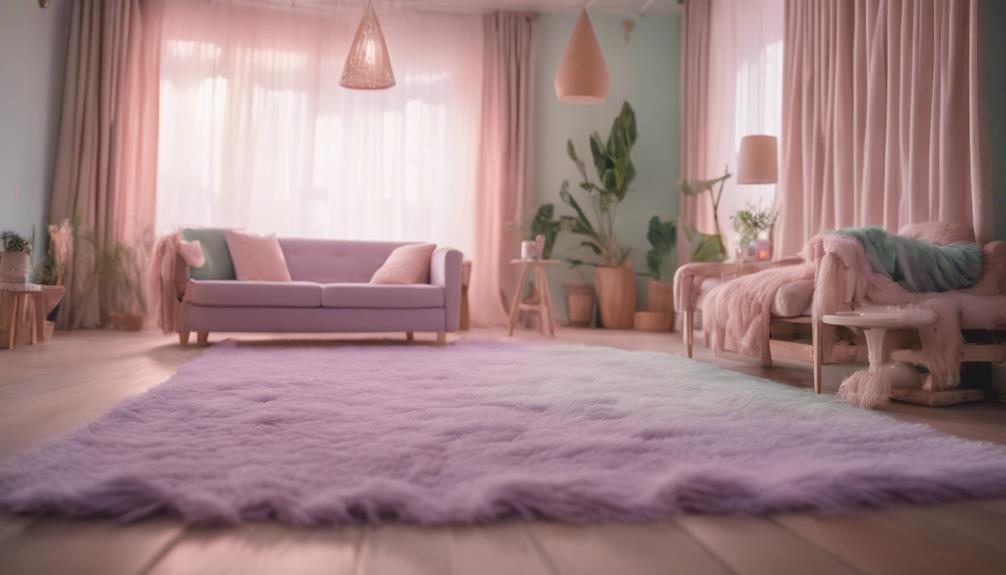
When it comes to flooring, you can really enhance your pastel aesthetic with options like pastel-patterned area rugs or herringbone tiles.
Consider playful choices like pastel polka dot vinyl flooring to add a whimsical touch.
Each of these elements can create a cohesive and inviting atmosphere in your room.
Pastel-Patterned Area Rug
Transform your space with a pastel-patterned area rug that adds warmth and softness while enhancing the overall aesthetic of your room. These rugs often feature soft and delicate designs, incorporating light hues like mint green, blush pink, or pale lavender. Patterns such as florals, gingham, or subtle geometric shapes align perfectly with the pastel theme, providing visual interest without overwhelming your decor.
When choosing a rug, opt for breathable materials like cotton or wool to guarantee comfort and durability. A well-placed pastel-patterned area rug can define spaces within your room, creating cozy nooks or highlighting specific decor elements. Not only does it add texture underfoot, but it also contributes to the serene ambiance that pastel aesthetics aim for.
Additionally, pastel rugs are versatile and can be easily coordinated with other pastel decor items, such as throw pillows, curtains, or wall art, to achieve a cohesive look. By incorporating a pastel-patterned area rug, you'll elevate your space, making it feel inviting and stylish while staying true to the soft and delicate charm of your pastel aesthetic room.
Pastel Herringbone Patterned Floor Tiles
Pastel herringbone patterned floor tiles bring a stylish and visually appealing option to your room's flooring, enhancing the soft aesthetic established by rugs and other decor. The unique V-shaped arrangement of the herringbone pattern adds depth and texture, making it a favored choice in modern pastel-themed interior design.
You'll find these pastel tiles available in various hues, such as soft pink, mint green, and light lavender, which seamlessly complement your existing pastel decor elements. Whether you're redecorating your living room or kitchen, installing pastel herringbone tiles can create a striking focal point that elevates your space.
These tiles are often made from durable materials like ceramic or porcelain, ensuring that they not only look great but also stand the test of time while maintaining their vibrant color. With their combination of functionality and design, pastel herringbone floor tiles can transform your room into a chic, welcoming environment.
Plus, they effortlessly tie together the entire pastel aesthetic, making your interior design vision a reality. So, consider these tiles for your next flooring project to achieve that dreamy pastel look you desire.
Pastel Polka Dot Vinyl Flooring
Looking to add a playful touch to your space? Pastel polka dot vinyl flooring offers a cheerful and inviting aesthetic that perfectly complements any pastel-themed room. This flooring combines delightful patterns with soft colors, creating an atmosphere that feels both fun and stylish.
One of the best things about pastel polka dot vinyl flooring is its durability. It's water-resistant, making it ideal for high-traffic areas like kitchens and bathrooms without sacrificing its charming appearance. Available in a variety of pastel shades such as mint green, baby pink, and lavender, you can easily customize it to match your decor style.
Installing vinyl flooring is a breeze, often requiring less time and effort than other options, making it perfect for DIY enthusiasts. Once laid down, this flooring can truly enhance your space, providing a whimsical touch that ties together other pastel elements in your room.
Can the Tips for Creating an Aesthetic Coquette Bedroom Also Apply to Creating a Pastel Aesthetic Room?
Yes, the tips for creating an aesthetic coquette bedroom can also apply to creating a pastel aesthetic room. Both design styles often prioritize soft, romantic colors, elegant decor, and a touch of whimsy. By incorporating the create aesthetic coquette bedroom tips, you can easily achieve a beautiful pastel aesthetic room.
Conclusion
By incorporating soft colors, cozy furniture, and whimsical decor, you can easily create a pastel aesthetic room that reflects your personality.
Remember to choose the right lighting to enhance the soothing ambiance and consider your flooring options to tie everything together.
With these tips and inspirations, you'll transform your space into a dreamy retreat, perfect for relaxation and creativity.
So, let your imagination run wild and embrace the pastel vibes in your room!
